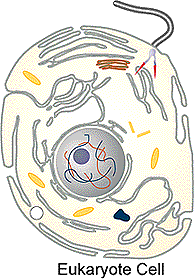
Study behavioral objective 1 and read the pages indicated by B-3 to get an overview of basic cell structure and function. In your notes draw a figure representing a plant and animal cell. Label the following structures and write a brief description (include a function) for each of the structures: cell wall, cell membrane (plasma membrane), cytoplasm, nucleus. All cells contain a cell membrane. All plant cells secrete an extracellular substance (cellulose) to the exterior side of the cell membrane which is called a cell wall. Animal cells usually to not secrete an extracellular substance; therefore, they consist of a naked protoplast. Protoplasm includes only the living part of a cell. Some animal cells do secrete extracellular substances such as protein (ex. hair shaft) on one side of the cell. The cell wall in plant cells and hair, finger nails in animal cells are the nonliving portion of a cell.
.Plant Cell Type

The figure above show how a cell wall in formed in newly formed plant cells.
The outside structure is the primary cell wall.
The dark stained structures are nuclei.
The yellow structure lining the inside of the cell wall is the cell
membrane.
The space between the nucleus and the cell membrane is the cytoplasm.
9. Which structures are included in protoplasm.
a) cytoplasm, nucleus, cell membrane,
cell wall
b) cytoplasm, nucleus, cell membrane,
c) cytoplasm, nucleus, cell membrane,
extracellular protein
d) nucleus, cell membrane, cytoplasm,
extracellular secretions
Press here to check answer. click
The cytoplasm consists of all material inside the cell membrane
and outside the nucleus. Within the cytoplasm are various type of structures
which function to maintain the cell and carry out its function called organelles.
Organelles within the cell are analogous to organs in the human body. Organelles
are suspended in a semi-liquid substance (sol). The nucleus contains
the DNA molecules which is the repository of genetic information that controls
all of the cells activities including cell division. Compared to the cytoplasm
the substance inside the nucleus is more solid
(gel). The cell membrane surrounds the cytoplasm of all cells.
It not only contains the liquid (sol) of the cytoplasm but it also controls
the substance which may enter or leave the cell (selective exchange of
materials in and out of the cell.
Animal Cell Type
The figure above shows an animal cell with an outer cell membrane, organelles and nucleus.
The outside membrane represents its cell membrane. The gray structure
in the center with the red and blue DNA molecules represents the nucleus
(gel). The yellow space between the cell membrane and nucleus represents
the cytoplasm (sol) with organelles scattered throughout.
10. Match the following description or activity to the correct structure listed below:
A) cell wall B) nucleus C) cytoplasm D) protoplasm E) cell membrane
1.
Allows only glucose sugars to enter the cell while preventing sucrose
from entering.
2. Contains
the cell's genetic material.
3. Keeps
the cells organelles suspended in a liquid medium.
4. Protects
the living part of a plant cell from exterior elements
5. Surrounds
the living part of all cells.
1 2 3 4 5
a)
A
C
D
B
E
b) D
B
C
A
E
c) E
B
C
A
D
d) B
E
C
A
D
Press here to check answer. click
This is the end of lesson one. Click here to move back
to the Biology 108N home page and lesson two, Cell Membranes.
click
For information on how to use this page, go to How
to Use This Site.
Created by the Center for Learning Technologies, Academic Technology Services.
Last modified October 22, 1997.